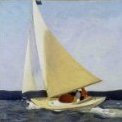-
Posts
1,171 -
Joined
-
Last visited
Reputation Activity
-
 jud got a reaction from justsayrow in Question about shaping/sanding with files
jud got a reaction from justsayrow in Question about shaping/sanding with files
Using a file card will help keep the teeth clean, can keep them even cleaner by rubbing chalk on the teeth. Work it in to the bottom of the grooves, then wipe the file clean with a rag, leaving the chalk in the grooves. Always lifting the file on the back stroke, is probably a habit you already have. The chalk will keep the filings from building up and sticking at the bottom of the grooves and make the file easier to clean. There is a method using an overnight soak in acid that restores a file, never tried it myself but a friend was bragging about the results he got by doing that. He has a rotary table of mine, when I go get it I will sneak a look at his files.
jud
-
 jud got a reaction from BANYAN in Question about shaping/sanding with files
jud got a reaction from BANYAN in Question about shaping/sanding with files
There is a video showing the acid sharpening of dull files.
Going to need to enter it yourself, don't know how to make it easy
Edited by Moderator - I loaded the video into the post. It was a bit hard to find using the previous link.
-
 jud got a reaction from Jay 1 in Question about shaping/sanding with files
jud got a reaction from Jay 1 in Question about shaping/sanding with files
There is a video showing the acid sharpening of dull files.
Going to need to enter it yourself, don't know how to make it easy
Edited by Moderator - I loaded the video into the post. It was a bit hard to find using the previous link.
-
 jud reacted to jerry_bee in Making sense of Zebra View in SolidWorks
jud reacted to jerry_bee in Making sense of Zebra View in SolidWorks
Zebra shading allows to determine the smoothness of a hull. The more strips are parallel, the flatter surface along them. The higher density of strips, the higher degree of the hull's curvature.
-
 jud reacted in Question about shaping/sanding with files
jud reacted in Question about shaping/sanding with files
Thanks for the video Jud. I'm going to give that a try.
-
 jud reacted to Jwvanost in Question about shaping/sanding with files
jud reacted to Jwvanost in Question about shaping/sanding with files
Wow that's pretty impressive. It doesn't look to awful complex to do either. THanks so much jud.
-
 jud got a reaction from Dan Vadas in Question about shaping/sanding with files
jud got a reaction from Dan Vadas in Question about shaping/sanding with files
There is a video showing the acid sharpening of dull files.
Going to need to enter it yourself, don't know how to make it easy
Edited by Moderator - I loaded the video into the post. It was a bit hard to find using the previous link.
-
 jud got a reaction from NenadM in Cutty Sark by Sailcat - FINISHED - Revell - 1/96 - PLASTIC - Rescue kit bash morphed to Dame Tisane
jud got a reaction from NenadM in Cutty Sark by Sailcat - FINISHED - Revell - 1/96 - PLASTIC - Rescue kit bash morphed to Dame Tisane
I thought braces were those things that people like me use to keep my pants up, the belt still works, but. Thinking of ordering a pair, be more comfortable than taking a double turn on the buckle and giving it a tug before securing.
jud
-
 jud got a reaction from WackoWolf in Question about shaping/sanding with files
jud got a reaction from WackoWolf in Question about shaping/sanding with files
Will find out which Lindsay book he found the method in and the details.
jud
-
 jud got a reaction from NMBROOK in Deck beam Scarphs?
jud got a reaction from NMBROOK in Deck beam Scarphs?
Deck beams do more than keeping the deck up, posts can do that, When a ships bow hits the next swell with the bow canted down from the swell she is riding, the upper ends of the ribs, because the planking is in compression, will want to move out because of those forces. When she crests a swell, both ends are not supported as well as amidships so the planking goes into tension and tries to push the ribs together. Without those deck beams the ship would tear its self apart. All of the structural members of a floating ship are constantly changing from tension to compression and all beams have dual rolls, one to keep the ship together and placed so the crew can live aboard. Because of the constant changing of the forces working on a ship, joints are well thought out.
jud
-
 jud got a reaction from trippwj in Deck beam Scarphs?
jud got a reaction from trippwj in Deck beam Scarphs?
Deck beams do more than keeping the deck up, posts can do that, When a ships bow hits the next swell with the bow canted down from the swell she is riding, the upper ends of the ribs, because the planking is in compression, will want to move out because of those forces. When she crests a swell, both ends are not supported as well as amidships so the planking goes into tension and tries to push the ribs together. Without those deck beams the ship would tear its self apart. All of the structural members of a floating ship are constantly changing from tension to compression and all beams have dual rolls, one to keep the ship together and placed so the crew can live aboard. Because of the constant changing of the forces working on a ship, joints are well thought out.
jud
-
 jud reacted to NMBROOK in Deck beam Scarphs?
jud reacted to NMBROOK in Deck beam Scarphs?
This is fun Wq 3296,when I say random,I mean occuring on random beams,not placed randomly on a beam.The scarph joints,whether single or double would be equal about the centreline.Coming from a structural engineering background,I hear what you are saying.In this instant the camber is radial and to allow water to drain off and does not drop out.I do know what you mean having built several bridges with Parabolic cambers that allow the structure to deflect to almost dead flat under load.The supporting structure of the deck,columns and hanging knees was designed to minimise any movement in the athwartships plane.I would say that cutting the scarphs horizontally would result in a weaker beam in the vertical plane,but that is just my opinion.If anyone fancies a go at finite element analysis then feel free The main problem being with a tapered scarph is varying amounts of material either side of the beams neutral axis.
Kind Regards
Nigel
-
 jud reacted to wq3296 in Deck beam Scarphs?
jud reacted to wq3296 in Deck beam Scarphs?
Folks,
Nice post. From an engineering point of view, I can't see why builders of wooden ships would ever use timbers of that length for deck structure, even if available. No matter how you slice it and dice, intermediate support columns or bearing walls would absolutely be necessary under a very long deck beam because it would deflect a considerable amount just from its own weight. These are the same principals used in building design and construction today. See Longridge's book on the Victory - it looks like a forest below decks for all the columns in place. Accordingly, if columns are required anyway, why not use shorter deck beams designed for a specific acceptable deflection? Shorter beams would be easier to install and readily available. Further, except for the keel and other members that are fully supported, I expect that the scarcity of long timbers was not the reason why they weren't necessarily used for deck sub structure. The requirement for columns necessitated by the live and dead loads associated with sailing ships would over ride the need for super long deck timber, in my opinion. Note that ideally, the scarph joints would be horizontal type centered over column locations where you have minimum moment but maximum shear load, which is resisted by the reaction at the column.
I would suggest you use the scarphed joints and place them at regular intervals. I doubt they were placed randomly, particularly on a 17th century war ship. In some instances where long spans were necessary and columns were not workable, I expect deck beams would have been lapped side by side, with the length of lap made long enough to occur well past the point of maximum moment which would be center span. I am not sure how far structural design had advanced during the 17-18 centuries, but considering some of the cathedrals built during that time, I expect it was fairly advanced and would have extended to ship building.
Note that I am offering what I think are common sense solutions based on time tested engineering principals. Of course, there may be information available that says I'm all wet. However, if you think I'm all wet please provide hard evidence to support your position. Nice topic and thank you for bringing it up. Maybe we can all learn something.
wq3296
-
 jud reacted to dgbot in dry brushing
jud reacted to dgbot in dry brushing
It is a process of weathering. After putting paint on the brush you wipe most of it off and then paint with the rest. With practice you can achieve different highlights and shades.
David B
-
 jud reacted to Don9of11 in Making sense of Zebra View in SolidWorks
jud reacted to Don9of11 in Making sense of Zebra View in SolidWorks
Here is an example of a Bounty class launch that has a perfectly shaped elliptical hull. In the real world you would never see this, at least I don't think you would. I would think you would see symmetry on the view of the bottom hull but that must depend on the position of the cube and the mirrored surface of the boat. The lines do flow all together so this hull is smooth.
I think this could be a good visual tool to easily see bad spots in a hull but ultimately its going to be the traditional measurement of waterlines, buttock lines, etc. that determine the fairness of the hull.
-
 jud reacted to Don9of11 in Making sense of Zebra View in SolidWorks
jud reacted to Don9of11 in Making sense of Zebra View in SolidWorks
If I understand Zebra lines, they represent the smoothness of a surface. In the top view, my ship the lines are all contiguous until you get to the dead flat and just forward of that the zebra line gets smudged out. The same is true for the bottom view. This indicates there is a problem, a dent or some other deviation. The same thing can be seen in the aft part of the ship near the keel and other areas if you pay close attention. Wherever the zebra lines break or fail to merge together smoothly there is some kind of deviation in the hull and in fact by measuring various points along the waterlines (not shown here) I do indeed have issues with the frames just forward of the dead flat and probably in other areas as well.
As with anything you see for the first time, its difficult to determine the significance of the zebra lines without a comparison to a goodly faired hull. If one could scan the hull of a real ship or even an admiralty model we might be surprised at the results. For all I know the pattern of these lines might be acceptable at the scales we build our ships.
-
 jud reacted to AON in Making sense of Zebra View in SolidWorks
jud reacted to AON in Making sense of Zebra View in SolidWorks
Zebra View is a mirror reflection of lines on your shape ... your shape is the mirror
as the shape changes the reflection of the lines adjust
it highlights changes in shape, mates and alignment
I am still having trouble wrapping my head around what it is telling me.
a perfectly fluid shape would, I believe, have long lines reflected... their direction might change but not sharply and they would change as a group
-
 jud reacted to AON in what is the ideal modelling table?
jud reacted to AON in what is the ideal modelling table?
Hoping to start building my table this weekend.
I acquired a 30” x 8 foot sheet of ¾” plywood and am now wondering if I should leave the table top at 30” or rip it down to the 24” wide I had originally planned to do.
I also have all the other lumber I could possibly require stock piled.
Picked up two lengths of ¾” Tee-rail for the table top as I’ve seen used on the forum.
Below are a few photos to christen the beginning of the build.
-
 jud got a reaction from AntonyUK in HMS Victory by AntonyUK - FINISHED - Scale 1:36 - cross-section
jud got a reaction from AntonyUK in HMS Victory by AntonyUK - FINISHED - Scale 1:36 - cross-section
Very impressive. Looks like all thread is one of your mainstays and a good idea.
jud.
-
 jud reacted to SGraham in Band Saw Question... or two
jud reacted to SGraham in Band Saw Question... or two
Mark, +1 on what Duff says. You can pick up an older 14" USA made band saw for not much money. Check out the older Deltas, Walker Turners, Atlas, etc. I have a late '40s Delta 14" that I use to size stock. I don't know how I would do without it. There is a website called VintageMachinery.org (owwm.com) that offers all kinds of support for folks who want to get an older machine and tune it up. They really are so much better than the new underpowered plastic/sheet metal things you can buy at the big box stores. With ebony or boxwood stock of the dimensions you mention, I'd resaw it on the band saw to thin enough pieces and then do the fine cutting of the planks on my small table saw.
Steve
-
 jud reacted to Richard Griffith in Band Saw Question... or two
jud reacted to Richard Griffith in Band Saw Question... or two
Hi Mark, I agree with Mark Taylor and Jud - buying cheap machines is a waste of money and is asking for a large dose of frustration. If you look for a decent machine in the second hand markets, such Ebay, Amazon, Craig's list, you might find a 14" Delta or similar in your price range. It may need cleaning and some replacement parts such as guide blocks, new blades and such. Be sure the motor and bearings are good, plus examine the rubber on the wheels.
You might be surprised at the versatility of the these machines and how much more you can do with it. I use my 14" Delta all the time. If I had to select it over my Delta 10" table saw, I would likely select the band saw, even though I use the table saw more. Each has its strengths and short falls. If I had to give up on one, I would probably have to see a shrink. LOL
The thin kerf saw blade on your table saw is a good option. Another option is to take your wood to some one who has a band saw.
Good luck with your project~!
Duff
-
 jud reacted to thibaultron in Preserving fragile kit plans
jud reacted to thibaultron in Preserving fragile kit plans
Thanks for the help! I'll try the sponge in the tube first, when I get back from vacation. I have some 4" PVC, I just need to get a couple end caps, and a union (cut a piece of plastic for the center to keep the plans and sponge separate). I can open the plans but don't want to handle them much, until I can strengthen them.
The Model Expo plans are for 1/48th POB, rather than the kits 1/96th solid hull, and cost more than I paid for the model. I'm going to keep track of their sales though, sometimes they have the plans on discount for reasonable prices. I did stumble across the instruction book for the 1/48th solid hull the succeeded this kit, so I now have much better instructions than the few page typed ones that came with the original kit.
-
 jud reacted to popeye the sailor in Holiday Harbor by popeye the sailor - 1:20 scale - multi build
jud reacted to popeye the sailor in Holiday Harbor by popeye the sailor - 1:20 scale - multi build
thanks Kevin......I haven't done much with them as of late. waiting till the weather get a bit warmer, so I can bring them out to the garage for a complete sanding job. they are going to be singular builds, but under the same subject / theme. one of my ideas though might not be as good as I once thought. I at least want them to be practical, so I threw the skating rink idea out. I do have an idea for the third hull, but it doesn't pertain to the subject. if that happens, this project will become a duo, and I'll save the other hull for that purpose. however this turns out, it will still be fun to do. thanks for looking in
-
 jud reacted to thibaultron in Preserving fragile kit plans
jud reacted to thibaultron in Preserving fragile kit plans
I have recently purchased an old Model Shipways (Yellow Box) model of the Benjamin Latham. I bought the older kit as it is 1/96th scale (close to a couple other fishing schooner kits I have), rather than the newer larger 148th kit they now offer. My problem is that the kit plans have aged to the point that they are quite brittle, to much so to simply have them photocopied. In addition they are folded, and are ripping in places. I am thinking of mounting them on a larger sheet, then having them copied and using the copies during building. Are there any suggestions on what adhesive to use, that would give some time to arrange the pieces, or some way to "soften" them, while still allowing for mounting? I think just taping them will only cause the plans to rip near the tape.
-
 jud reacted to popeye2sea in Gun tackel coiling-perfect coils vers some variations Questions
jud reacted to popeye2sea in Gun tackel coiling-perfect coils vers some variations Questions
I still maintain that the gun tackles were faked down and not coiled. Faking the tackles would allow them to run free an not kink or jam when the gun recoiled.










